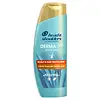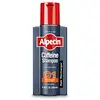What's inside
What's inside
 Key Ingredients
Key Ingredients

 Benefits
Benefits

 Concerns
Concerns

 Ingredients Side-by-side
Ingredients Side-by-side

Water
Skin ConditioningSodium Laureth Sulfate
CleansingSodium Lauryl Sulfate
CleansingSodium Chloride
MaskingCocamidopropyl Betaine
CleansingSodium Xylenesulfonate
Glycol Distearate
EmollientSodium Citrate
BufferingDimethiconol
EmollientPiroctone Olamine
PreservativeDimethicone
EmollientParfum
MaskingCitric Acid
BufferingSodium Benzoate
MaskingSodium Salicylate
PreservativeTea-Dodecylbenzenesulfonate
CleansingGuar Hydroxypropyltrimonium Chloride
Skin ConditioningMenthol
MaskingTocopheryl Acetate
AntioxidantTrideceth-10
CleansingTetrasodium EDTA
Sodium Hydroxide
BufferingHexyl Cinnamal
PerfumingNiacinamide
SmoothingAloe Barbadensis Leaf Juice
Skin ConditioningLinalool
PerfumingHydroxycitronellal
PerfumingGeraniol
PerfumingCitronellol
PerfumingBenzyl Alcohol
PerfumingTriethylene Glycol
MaskingPropylene Glycol
HumectantWater, Sodium Laureth Sulfate, Sodium Lauryl Sulfate, Sodium Chloride, Cocamidopropyl Betaine, Sodium Xylenesulfonate, Glycol Distearate, Sodium Citrate, Dimethiconol, Piroctone Olamine, Dimethicone, Parfum, Citric Acid, Sodium Benzoate, Sodium Salicylate, Tea-Dodecylbenzenesulfonate, Guar Hydroxypropyltrimonium Chloride, Menthol, Tocopheryl Acetate, Trideceth-10, Tetrasodium EDTA, Sodium Hydroxide, Hexyl Cinnamal, Niacinamide, Aloe Barbadensis Leaf Juice, Linalool, Hydroxycitronellal, Geraniol, Citronellol, Benzyl Alcohol, Triethylene Glycol, Propylene Glycol
Water
Skin ConditioningSodium Laureth Sulfate
CleansingLaureth-2
CleansingDisodium Laureth Sulfosuccinate
CleansingSodium Lauroyl Glutamate
Sodium Chloride
MaskingCaffeine
Skin ConditioningPanthenol
Skin ConditioningParfum
MaskingPEG-120 Methyl Glucose Dioleate
EmulsifyingHydrolyzed Wheat Protein
Skin ConditioningCitric Acid
BufferingSodium Citrate
BufferingMenthol
MaskingPEG-40 Hydrogenated Castor Oil
EmulsifyingPotassium Sorbate
PreservativePolyquaternium-7
Disodium EDTA
Sodium Benzoate
MaskingZinc PCA
HumectantNiacinamide
SmoothingLimonene
PerfumingTocopherol
AntioxidantPhenoxyethanol
PreservativeMethylparaben
PreservativePropylparaben
PreservativeCI 42090
Cosmetic ColorantCI 60730
Cosmetic ColorantWater, Sodium Laureth Sulfate, Laureth-2, Disodium Laureth Sulfosuccinate, Sodium Lauroyl Glutamate, Sodium Chloride, Caffeine, Panthenol, Parfum, PEG-120 Methyl Glucose Dioleate, Hydrolyzed Wheat Protein, Citric Acid, Sodium Citrate, Menthol, PEG-40 Hydrogenated Castor Oil, Potassium Sorbate, Polyquaternium-7, Disodium EDTA, Sodium Benzoate, Zinc PCA, Niacinamide, Limonene, Tocopherol, Phenoxyethanol, Methylparaben, Propylparaben, CI 42090, CI 60730
 Reviews
Reviews

Ingredients Explained
These ingredients are found in both products.
Ingredients higher up in an ingredient list are typically present in a larger amount.
Citric Acid is an alpha hydroxy acid (AHA) naturally found in citrus fruits like oranges, lemons, and limes.
Like other AHAs, citric acid can exfoliate skin by breaking down the bonds that hold dead skin cells together. This helps reveal smoother and brighter skin underneath.
However, this exfoliating effect only happens at high concentrations (20%) which can be hard to find in cosmetic products.
Due to this, citric acid is usually included in small amounts as a pH adjuster. This helps keep products slightly more acidic and compatible with skin's natural pH.
In skincare formulas, citric acid can:
While it can provide some skin benefits, research shows lactic acid and glycolic acid are generally more effective and less irritating exfoliants.
Most citric acid used in skincare today is made by fermenting sugars (usually from molasses). This synthetic version is identical to the natural citrus form but easier to stabilize and use in formulations.
Read more about some other popular AHA's here:
Learn more about Citric AcidMenthol is a compound found in mint plants, such as peppermint. In its pure form, it is a clear crystalline substance.
Menthol is known for its cooling sensation; however, the cooling is actually from your skin being sensitized. Menthol can worsen rosacea. We recommend speaking with a professional if you have concerns.
Menthol also has antimicrobial properties.
Learn more about MentholNiacinamide is a multitasking form of vitamin B3 that strengthens the skin barrier, reduces pores and dark spots, regulates oil, and improves signs of aging.
And the best part? It's gentle and well-tolerated by most skin types, including sensitive and reactive skin.
You might have heard of "niacin flush", or the reddening of skin that causes itchiness. Niacinamide has not been found to cause this.
In very rare cases, some individuals may not be able to tolerate niacinamide at all or experience an allergic reaction to it.
If you are experiencing flaking, irritation, and dryness with this ingredient, be sure to double check all your products as this ingredient can be found in all categories of skincare.
When incorporating niacinamide into your routine, look out for concentration amounts. Typically, 5% niacinamide provides benefits such as fading dark spots. However, if you have sensitive skin, it is better to begin with a smaller concentration.
When you apply niacinamide to your skin, your body converts it into nicotinamide adenine dinucleotide (NAD). NAD is an essential coenzyme that is already found in your cells as "fuel" and powers countless biological processes.
In your skin, NAD helps repair cell damage, produce new healthy cells, support collagen production, strengthen the skin barrier, and fight environmental stressors (like UV and pollution).
Our natural NAD levels start to decline with age, leading to slower skin repair, visible aging, and a weaker skin barrier. By providing your skin niacinamide, you're recharging your skin's NAD levels. This leads to stronger, healthier, and younger looking skin.
Another name for vitamin B3 is nicotinamide. This vitamin is water-soluble and our bodies don't store it. We obtain Vitamin B3 from either food or skincare. Meat, fish, wheat, yeast, and leafy greens contain vitamin B3.
The type of niacinamide used in skincare is synthetically created.
Learn more about NiacinamideParfum is a catch-all term for an ingredient or more that is used to give a scent to products.
Also called "fragrance", this ingredient can be a blend of hundreds of chemicals or plant oils. This means every product with "fragrance" or "parfum" in the ingredients list is a different mixture.
For instance, Habanolide is a proprietary trade name for a specific aroma chemical. When used as a fragrance ingredient in cosmetics, most aroma chemicals fall under the broad labeling category of “FRAGRANCE” or “PARFUM” according to EU and US regulations.
The term 'parfum' or 'fragrance' is not regulated in many countries. In many cases, it is up to the brand to define this term.
For instance, many brands choose to label themselves as "fragrance-free" because they are not using synthetic fragrances. However, their products may still contain ingredients such as essential oils that are considered a fragrance by INCI standards.
One example is Calendula flower extract. Calendula is an essential oil that still imparts a scent or 'fragrance'.
Depending on the blend, the ingredients in the mixture can cause allergies and sensitivities on the skin. Some ingredients that are known EU allergens include linalool and citronellol.
Parfum can also be used to mask or cover an unpleasant scent.
The bottom line is: not all fragrances/parfum/ingredients are created equally. If you are worried about fragrances, we recommend taking a closer look at an ingredient. And of course, we always recommend speaking with a professional.
Learn more about ParfumSodium Benzoate is a preservative. It's used in both cosmetic and food products to inhibit the growth of mold and bacteria. It is typically produced synthetically.
Both the US FDA and EU Health Committee have approved the use of sodium benzoate. In the US, levels of 0.1% (of the total product) are allowed.
Sodium benzoate works as a preservative by inhibiting the growth of bacteria inside of cells. It prevents the cell from fermenting a type of sugar using an enzyme called phosphofructokinase.
It is the salt of benzoic acid. Foods containing sodium benzoate include soda, salad dressings, condiments, fruit juices, wines, and snack foods.
Studies for using ascorbic acid and sodium benzoate in cosmetics are lacking, especially in skincare routines with multiple steps.
We always recommend speaking with a professional, such as a dermatologist, if you have any concerns.
Learn more about Sodium BenzoateChances are, you eat sodium chloride every day. Sodium Chloride is also known as table salt.
This ingredient has many purposes in skincare: thickener, emulsifier, and exfoliator.
You'll most likely find this ingredient in cleansers where it is used to create a gel-like texture. As an emulsifier, it also prevents ingredients from separating.
There is much debate on whether this ingredient is comedogenic. The short answer - comedogenic ratings don't tell the whole story. Learn more about comegodenic ratings here.
The concensus about this ingredient causing acne seems to be divided. Research is needed to understand if this ingredient does cause acne.
Scrubs may use salt as the primary exfoliating ingredient.
Learn more about Sodium ChlorideSodium Citrate is the sodium salts of citric acid. In skincare, it is used to alter pH levels and acts as a preservative.
Its main functions are to maintain the pH of a product and neutralize metal ions.
The acidity of our skin is maintained by our glands and skin biome; normal pH level of skin is slightly acidic (~4.75-5.5).
Being slightly acidic allows our skin to create an "acid mantle". This acid mantle is a thin barrier that protects our skin from bacteria and contaminants.
Learn more about Sodium CitrateSodium Laureth Sulfate (SLES) is a foaming, cleansing, and emulsifying ingredient. It is created from palm kernel oil or coconut oil. SLES is not the same as sodium lauryl sulfate. It is much milder and less likely to irritate.
SLES helps create foam in personal products. It also prevents ingredients from separating, helping to elongate the shelf life.
Sodium Laureth Sulfate is a type of sulfate. It can be drying. We recommend speaking with a professional about using this ingredient if you have concerns.
Learn more about Sodium Laureth SulfateWater. It's the most common cosmetic ingredient of all. You'll usually see it at the top of ingredient lists, meaning that it makes up the largest part of the product.
So why is it so popular? Water most often acts as a solvent - this means that it helps dissolve other ingredients into the formulation.
You'll also recognize water as that liquid we all need to stay alive. If you see this, drink a glass of water. Stay hydrated!
Learn more about Water